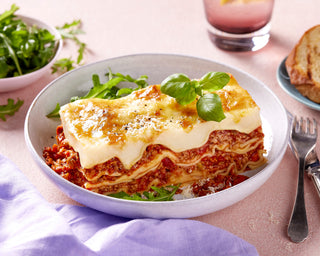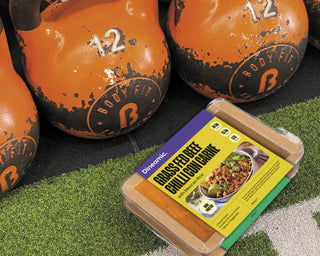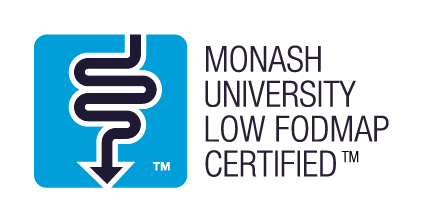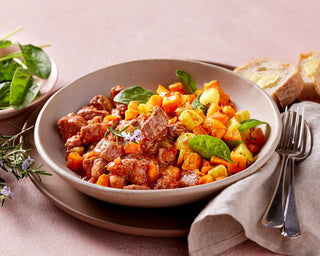
Believe it or not, there are 100,000 times more microbes in your gut than there are people on Earth. Oh my gut! Yes, it’s hard to believe how so much exists inside that relatively small organ.
Unfortunately, many of us don’t tune in and listen to our guts - and it’s probably about time we did. Gut health is surging in awareness, with a plethora of studies suggesting links between the gut and almost every critical function in our bodies.
Taking care of our gut and giving it a little bit of TLC often starts with what we can control. And that’s what we choose to eat and drink. With as many as one in five Australians experiencing the symptoms of irritable bowel syndrome (IBS), it’s likely many of us may benefit from changes to our diet.
One diet many individuals with IBS choose to follow is a Low FODMAP one. While not perfect for everyone, it can help relieve gastrointestinal symposts. You shouldn’t self diagnose IBS, however. Always seek professional help as symptoms can mimic those of coeliac disease, inflammatory bowel disease, endometriosis and bowel cancer.
So what is a Low FODMAP diet? And how could you get started? In our ultimate guide to Low FODMAP, we’ll cover everything you need to know about the diet, including:
- What is a Low FODMAP diet
- Why gut health is so important
- Where FODMAPs are found
- FODMAP foods to avoid
- What the phases of a Low FODMAP diet are
- Low FODMAP meal planning
- Low FODMAP resources
- Tips for eating out on a Low FODMAP diet
- Dineamic’s Low FOMDAP menu
What is a Low FODMAP diet?
The Low FODMAP diet was developed in 1999 by the research team at Monash University, Melbourne. A Low FODMAP diet seeks to limit foods that have been proven to aggravate the gut and cause IBS symptoms.
The Low FODMAP diet, although called a diet, is not a weight loss plan. The diet is best undertaken with the support of a dietitian or healthcare professional, and begins with a 2 to 6 week period of high restrictions. Certain foods can usually then be slowly re-introduced.
In short, FODMAPs are a group of poorly absorbed fermentable short chain carbohydrates that can lead to excessive fluid and gas production, often causing gastrointestinal discomfort (e.g. bloating, abdominal pain and distension in some people).
FODMAP stands for:
- Fermentable – Process through which gut bacteria ferment undigested carbohydrate to produce gases
- Oligosaccharides – Fructans and GOS, found in foods such as wheat, rye, and onions
- Disaccharides – two sugar molecules
- Monosaccharides – one sugar molecule
- And Polyols – sugar alcohols
Dietary restriction of FODMAPs or what is known as the low FODMAP diet reduces the fermentable load on the colon, thereby reducing gas production and the internal expansion/pressure of the gut lumen increasing abdominal size. To take the science out of it – less FODMAPs = less stress on the colon, and less gas, pressure and discomfort.
What are common IBS symptoms?
When suffering from IBS, some people experience only mild to moderate symptoms, while others can experience debilitating symptoms which can affect their quality of life.
If you’re wondering if you may be suffering from IBS, common symptoms include:
- Abdominal pain or cramping that is often relieved by passing wind or faeces
- Alternating diarrhoea and constipation
- A sensation that the bowels are not fully emptied after passing a motion
- Abdominal bloating
- Mucus present in the stools
- Nausea
Remember, these symposts are not exclusive to IBS. You should seek the advice of a healthcare professional.
It’s also important to note that a Low FODMAP diet doesn't cure IBS. It simply makes life more comfortable for those who suffer from it - for those who the diet proves effective.
Why is gut health so important?
Some refer to the gut as ‘the second brain’, and they may be on to something. The gut contains between 50 and 100 million nerve cells. The gut is also connected to the brain through thick nerve cells, with many suggesting our gut health thus impacts all our decision-making.
If you struggle with getting a good night's sleep, you’ll also be interested to know that 95% of the body’s serotonin is stored in the gut. Serotonin is a very important signaling molecule, a neurotransmitter that sends messages throughout our body impacting sleep, mood, appetite, pain sensitivity and more.
The gut is home to a vast array of bacteria, archaea, fungi and even viruses. Our guts have a delicate balance, and while these microbiota may seem insignificant, we are dependent on each other for survival.
Stress and other lifestyle factors can wreak havoc on the gut, so practicing a healthy diet, partaking regular exercise and other mindfulness activities can go a long way to improving the health of the gut, and general health and wellbeing overall.
Where are FODMAPs found?
FODMAPs are largely found within a wide range of carbohydrate-rich foods including certain fruits, vegetables, breads, cereals, nuts, legumes and confectionery. Careful and precise analysis of foods is required to understand its FODMAP content.
Low FODMAP foods
When it comes to eating low FODMAP foods, portion sizes are very important. If your gut is particularly sensitive, eating a combination of low FODMAP ingredients throughout the day may still trigger symptoms. This is referred to as ‘stacking’.
Stacking becomes problematic when you eat multiple quantities of one or more low FODMAP foods that come from the same FODMAP group. These FODMAPs can then accumulate and trigger symptoms.
When eaten as part of a balanced Low FODMAP diet, you may choose to include some of the below foods.

FODMAP foods to avoid
If following a Low FODMAP diet, you may reduce or eliminate the below foods.

What are the phases of a Low FODMAP diet?
Following a Low FODMAP diet doesn’t need to be forever. Once you understand your IBS trigger foods and food intolerances, you can adapt your diet. While you may eat Low FODMAP meals to reduce inflammation and other symptoms long-term, you may be able to reintroduce some FODMAPs by following the three phases of the diet. They are:
- Low FODMAP Diet - The amount of time spent in this phase should be determined in consultation with your nutritionist or healthcare professional, but it usually lasts from 2 to 6 weeks.
- FODMAP Reintroduction - Determine which foods and FODMAPs trigger symptoms, and which don’t by reintroducing FODMAP foods. Consult your dietician if you need help with this step, it will usually take 6 to 8 weeks and can be tricky.
- FODMAP Personalisation - Everyone’s food intolerances are different, so personalise and establish your longer term, personalised FODMAP diet. It’s not practical to eliminate certain FODMAP groups forever if they aren’t triggering symptoms, so work with your nutritionist or healthcare professional to determine what is best for you.
Low FODMAP resources
To easily identify where FODMAPs occur, the Low FODMAP Monash App is an excellent resource. The app uses a traffic light system to categorise foods into what can be eaten freely and what should be limited. With the largest available FODMAP food database, the app has helped millions of people manage their IBS.
If you’re in search of an alternative, resources such as the FODMAP Friendly App might be useful.
We also supply our meals to FODShop, an online store which supplies low FODMAP products in Australia. You can visit their site to learn about new low FODMAP product launches, gut health and more.
Tips for eating out on a Low FODMAP diet
One of the more challenging aspects when following a Low FODMAP diet is eating out, especially as onion and garlic is in so many sauces, marinades, sides and more. To make your life a little bit easier, here’s some tips when eating out:
- Call ahead and enquire if there’s anything on the menu (or options) that cater for those on a Low FODMAP diet - if you’ve got some time, do your research and look at menus online.
- Protein and vegetables are generally a safe option. For example, grilled fish or a steak with potato and a green salad (no onion).
- Vietnamese and Japanese are usually good options. For Vietnamese, you might have rice paper rolls or pho. For Japanese, you might try sushi and miso soup.
- When eating Italian, opt for gluten-free pizza and pasta. Ask for options without onion and garlic, or go with options like pasta with olive oil, fresh tomatoes and seafood.
Low FODMAP Swaps From Our Nutritionist
Hi I’m Kobe and I love all things food and cooking and so when it was advised that I follow a low FODMAP diet I was keen to find easy alternatives. I’ve got an extensive collection of low FODMAP substitutes in my pantry and fridge so I never have to miss out on a fun tasty recipes at home.
Onion- Sub for leek (blub and leaves combined) make sure you don’t consume over 2/3 cup or 45g.
Garlic- Sub for garlic-infused olive oil. Either you can purchase this at your local supermarket or make it yourself at home! All you have to do is simmer EVOO on low heat in a saucepan until it’s warm. Then, take off the heat, add in a couple peeled garlic cloves (halved if you want a stronger flavour) and allow to sit for approx. 2 hours. Strain into a clean jar and store in the fridge for up to 3 days.
Bread- Spelt Sourdough is my new (and soon to be yours) best friend! Whilst it’s not suitable for coeliacs, spelt contains less gluten and so may be easier to digest for some. This type of bread is high in fibre and nutrients such as protein, manganese, niacin and thiamine. This is tastier and healthier than processed gluten free bread.
Button Mushrooms- Sub for Oyster mushrooms, canned champignons (drained and rinsed).
Pumpkin- Stay clear from butternut and throw in a big Japanese style pumpkin in the shopping basket- they taste almost the same.
Honey- Rice malt syrup is a nice low-sugar option and brown sugar always provides a nice depth of flavour to baked goods.
Legumes- Whilst everyone is different, thoroughly rinsing canned chickpeas and lentils before adding it to your dishes at home is a great way to ensure you’re getting your legume fix without the repercussions. Remember to have max ¼ cup at a time.
Homemade Curries- Instead of purchasing jarred sauces such as korma or butter chicken, keep a nice collection of spices in your pantry and make your own sauce! I make sure I always have cardamon, turmeric, cumin seeds, ground coriander, chilli flakes, cloves and fresh ginger.
Homemade Italian- Similar to above, don’t be shy to explore different recipes and try make your own Italian dishes from scratch. Make sure you always have the following available- cans of chopped tomato, pure tomato paste, fresh herbs such as basil, parsley and rosemary. OR opt for a collection of cheap easy dried spices and herbs like thyme, oregano, bay leaves and sage.
Dineamic’s Certified Low FODMAP Menu
Don't sweat the traffic light system. Our Low FODMAP menu got the green light from Monash FODMAP Certified. Delicious, flavour-filled Low FODMAP lunches and dinners that don't sacrifice taste.
You can find our Meals For One, Meals For Two and soups via our website. Your tummy will thank you for it!
You can find our Meals For One, Meals For Two and soups via our website. You can also pick you favourite low-fodmap meals and save, with our Build Your Own Bundle.









